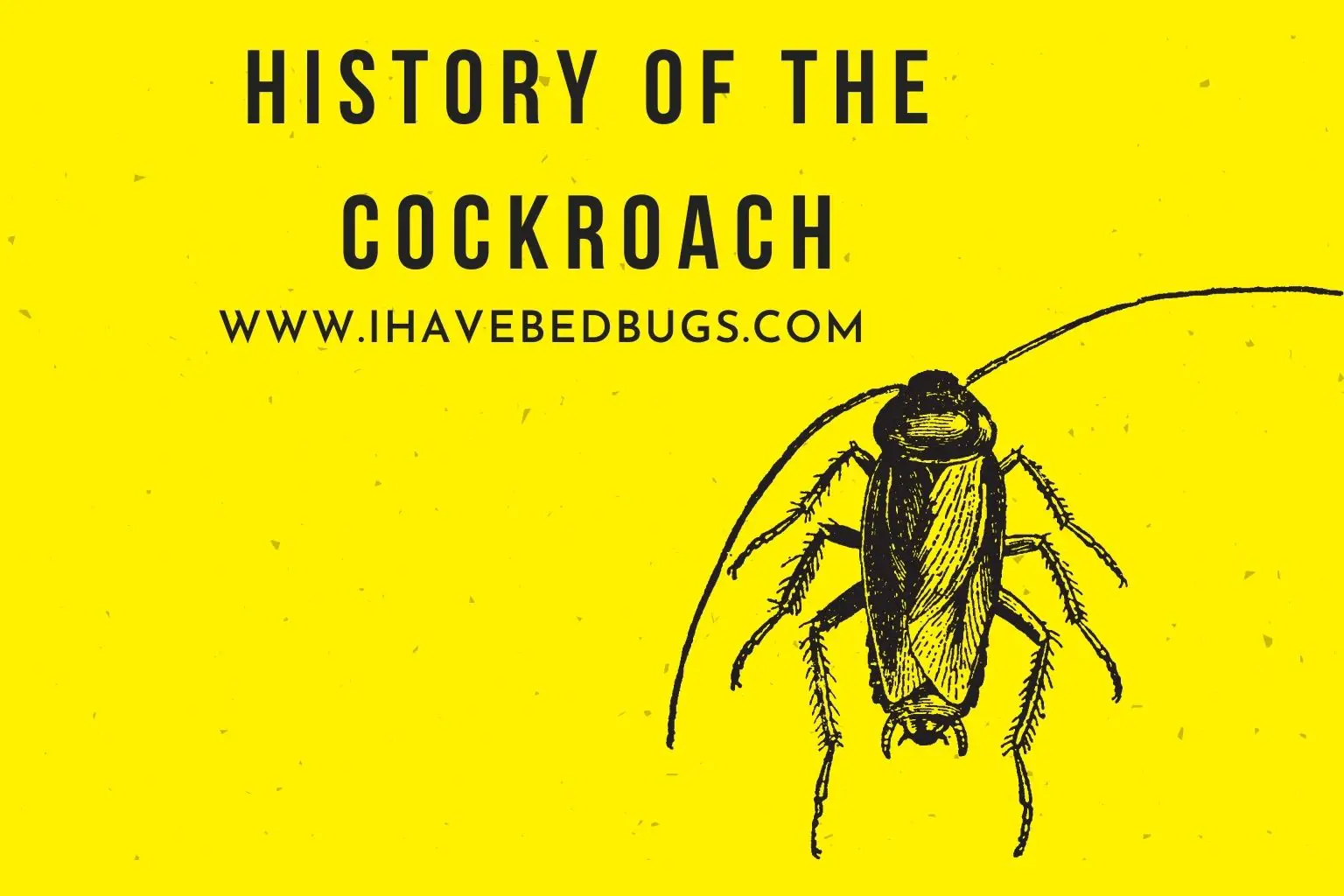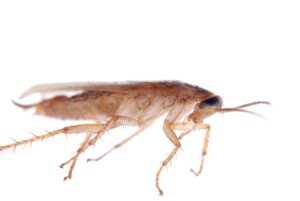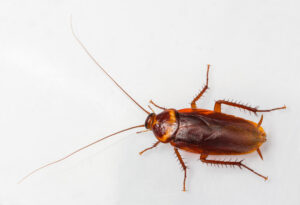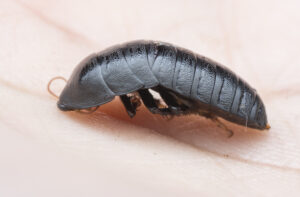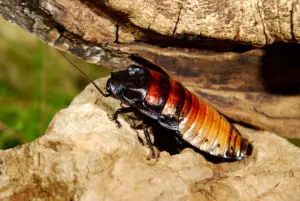The many different cockroach species are hardy players in the wild and have been since their birth over 250 million years ago. However, cockroaches are nightmarish household pests for humans, as many domestic modern cockroaches like the German cockroach and the American cockroach are common sightings.
And roaches aren’t only scary because they look disgusting; they’re also a health hazard. Cockroach allergens can trigger allergic reactions and asthma, and a cockroach bite can transmit nasty and dangerous bacteria to humans. And that’s part of the reason many homeowners allocate an annual or semi-annual pest control budget.
But no matter how hard we fight cockroaches, they’re not going anywhere. So roaches have been the hardiest insects on the planet for hundreds of millions of years, sharpening their survival skills.
This raises the question, “How have cockroaches survived for so long so successfully?” And to answer that, let’s take a look at the history of the cockroach.
What Is A Cockroach?
Before we get into the beginnings of cockroach history, we need to lay out what defines a cockroach first. The question “what is a cockroach?” may seem silly at first since most people can identify a roach at first glance. Still, it’s necessary considering how diverse the cockroach population is and the vast number of cockroach species on Earth.
And by “huge number,” we’re talking about 4,500 known cockroach species! For context, that’s not far off from the number of mammal species, 5,400.
However, not all cockroaches live indoors. Of the 4,500, only a few species (about 35) are considered common household pests, such as American or German cockroaches.
Other cockroaches live outdoors in various climate zones, such as tropical forests, grasslands, and deserts.
Cockroaches also come in various shapes and colors. Certain species of cockroaches are identified by their flattened body and reddish-brown/dark brown color, some with a hint of yellow on their backs, but did you know that some feral cockroaches come in sand-like and even green colors?
Cockroach Taxonomy
Scientifically, all cockroaches are insects part of the order Blattodea, which includes other insects like termites and mantises, which used to be in special orders until we learned they share a common ancestor with cockroaches.
Currently, we know of nine cockroach families within the order Blattodea:
- Anaplectidae: a small family that contains only two genera with 90+ species.
- Blaberidae: also known as giant cockroaches, this family is the second-largest by the number of species with about 650. Examples include the death’s head cockroach, the Madagascar hissing cockroach, and the giant burrowing cockroach.
- Blattidae: this family contains many common species that haunt our homes, such as the oriental cockroach, American cockroach, Australian cockroach, and Smokybrown cockroach.
- Corydiidae: many roaches in this family are called sand cockroaches because they’re commonly found in the desert. The most famous Corydiidae roach is the desert cockroach (A. investigata), white.
- Cryptocercidae: probably the most ancient family of cockroaches; Cryptocercidae roaches are relatively primitive and share more similarities with termites than other cockroach families. Examples include wood roaches and brown-hooded roaches, which live in rotting wood.
- Ectobiidae: Like Blattidae, this family includes many common household roaches such as the German cockroach, Asian cockroach, and brown-banded cockroach. Typically, most species in the family Ectobiidae are smaller than other cockroaches.
- Lamproblattidae: The smallest cockroach family has only three genera and ten species.
- Nocticolidae: another small family, Nocticolidae contains only 32 species in nine genera. This family includes the endangered Gerlach’s cockroach.
- Tryonicidae: this family includes only 17 known species in two genera. They’re typically smaller, emit a foul smell, and are found in Oceania.
Cockroach Etymology
If cockroaches are in the order Blattodea and none of the family names have anything to do with the word “cockroach,” why do we call them this funny-sounding name?
Cockroaches get their English name from the Spanish word “Cucaracha.” This name, combined with the words “cock” (the animal) and “roach” (the fish), inspired the name “cockroach.”
Cockroach Anatomy
Like many insects, cockroaches have three main regions: the head, thorax, and abdomen. They also have a pair of very noticeable and long antennae, three pairs of legs, and a hard exoskeleton cover on top that they shed (molt) several times in their lives.
Head
The head is where their antennae, mouthparts, and eyes are. A common myth is that cockroaches don’t have brains in their heads, which is why they can survive without a head for over a week.
However, that’s not true. Cockroaches do have brains in their heads; it’s just that their bodies aren’t as reliant on their brains as ours are on our brains, as most of their nervous system activity doesn’t happen here. Also, roaches breathe through tracheae in their sides, so they don’t need their heads for that either.
What a cockroach can’t do without a head is eat or drink, so when they’re decapitated, they eventually die of thirst (or hunger).
Anyway, cockroach antennae are very distinctive and look like two long threads. Still, they’re made of many tiny sensory parts that allow them to feel and smell the environment around them.
As for cockroach eyes, they’re not as refined as those of a fly, but they still allow them to see a wide field of view around them as a mosaic.
Lastly, their mouthparts consist of six parts that work together to eat. They have the labrum and labium as lips, two mandibles that cut like mammal incisors and canines, and two maxillae for chewing, like mammal molars.
Thorax
The thorax is the external layer around the cockroach’s body that holds its three pairs of legs and (if applicable) a pair of wings. Each wing is also segmented into a fore-wing and hind-wing.
Interestingly, male cockroaches almost always have wings, whereas females usually don’t. However, a female cockroach will have vestigial, dysfunctional wings in some cases.
Cockroaches have three legs on each side: the foreleg, mid-leg, and hind-leg. Each leg has three joints that split into four parts, all of which move harmoniously. These features give cockroaches incredible mobility over any surface and enable them to run up to three miles per hour. By this feat, the cockroach is the fastest insect.
The exoskeleton protective shell on the cockroach’s back protects it, and the cockroach molts it several times in its lifetime. When molted, the cockroach is vulnerable until it grows a new exoskeleton.
Abdomen
The abdomen contains the cockroach’s vital organs, such as the heart and stomach.
Cockroaches have a basic digestive system in their stomach that enables them to eat things that a mammal digestive system wouldn’t tolerate.
Cockroach Physicality
Cockroaches are very physically impressive and boast a successful evolutionary history thanks to their hardiness and physicality.
As mentioned above, cockroaches are very mobile as they can run up to three miles per hour on almost any surface. If humans could run at the same rate, we’d be capable of speeds up to 18 miles per SECOND!
Cockroaches can also jump nearly 50 times their body height. For comparison, if humans could jump that high, we’d be able to jump up to about 280 feet, roughly the height of a 20-story building.
When food is scarce, a cockroach will eat anything in front of it, animal feces, dead insects, vomit, or other cockroaches.
Cockroaches are nocturnal creatures not because they’re scared of the light or don’t like it but because they know they can hide better in the dark to avoid danger. That’s why roaches are often found in dark places, but if they appear in bright rooms, then it’s a sign of a severe cockroach infestation problem.
A common funny myth is that cockroaches will take over the world after humanity destroys itself in an all-out nuclear war because they can “withstand radiation.”
We can’t say this is true since cockroaches are still harmed by radiation despite having much higher radiation resistance than humans. But our bar isn’t that high, especially among insects, many of which are exceptionally radiation-resistant compared to humans.
Related Content:
Bugs that Look Like Bed bugs: 12 Insects Mistaken for Bed bugs
What Attracts Bed Bugs?
15 DIY Bed Bug Heaters
Cockroach History In A Nutshell
These mind-boggling cockroach stats beg the question, “how did this stonewall of an insect come to be?” And that’s what we’ll discuss in this section as we go over the history of cockroaches, from the earliest cockroach-like fossils up until the modern cockroach.
Ancient Cockroach Fossils
Scientists found fossils of ancient extinct cockroach relatives (known as roachids) dating back to 300 million years ago in the Carboniferous period. However, these roachids lacked some cockroach organs we know today.
Some scientists are skeptical about the relationship between these ancient roachids and modern cockroaches, incredibly since some parts of the roachids are not preserved in the fossils.
Some of these missing parts, like the hind wings and mouthparts, are important in determining the type of cockroach or if the creature is even a cockroach. Unfortunately, since the 20th century, we know that these roachids are also the ancestors of mantises and termites, which adds more doubt to whether they were “true cockroaches.”
Either way, cockroaches have changed very little from the roachids of the time.
Modern Cockroaches
The oldest modern cockroach fossils we have are the Cretaholocompsa montsecana and Valditermes brennae fossils from the Cretaceous period 120-130 million years ago. One analysis suggests the fossils were even from the Jurassic period, about 145 million years ago.
Although these fossils don’t represent all the thousands of cockroach species around today, they still show that cockroaches in their modern form have existed at least alongside the dinosaurs and have survived the dinosaur extinction event 66 million years ago.
Other research suggests that the extinction of the dinosaurs gave rise to modern cockroaches, who cleaned up the wild after the dinosaurs leftover massive amounts of dung that cockroaches ate.
Evolution And Adaptation
Cockroaches have always been adaptive creatures, learning to survive in the harshest conditions that don’t break their molecular biology apart.
Frighteningly for those struggling with a cockroach infestation, some research suggests that German cockroaches, some of the most common household roaches in the world, are learning to ignore their appetite for sugar, which we use to bait them into roach traps.
This isn’t to say that pest control is about to be futile – we’ll probably develop better techniques if roaches learn to avoid our bait. Instead, we’re putting this out to show you how highly adaptable cockroaches can be.
Types Of Cockroaches
As we’ve said above, cockroaches come in a myriad of shapes, sizes, and colors. There are almost as many species of cockroaches as there are of mammals on Earth, which is riveting and repellent in a sense.
We couldn’t cover every single species or genus of cockroaches in one article. Besides, only several species out of 4,600 pose a problem to humans, so we thought we’d cover the most relevant and popular ones.
The roaches we’re familiar with are domestic cockroaches, which like to live indoors off the inadvertent waste we leave to them as food. That’s why they’ll live in dank, warm, humid places in the house, such as under the kitchen sink or in the bathroom.
Other species prefer to live off the streets. They tend to live in the wilderness away from civilization, not literally, of course. We’ll also talk about a few of those feral species here to give you an idea.
So without further ado, let’s get right into the most popular domestic and feral cockroach species.
Domestic Cockroach Species
First, let’s talk about the most common household roaches, such as the German, American, Australian, Oriental, and brown-banded roaches.
German Cockroach
The German cockroach (Blattella germanica) is one of the smaller cockroach species, averaging a length of 0.5-0.6 inches. In color, male German cockroaches are a shade of tan brown, whereas females are dark brown.
German cockroach infestations are among the most common in the world. Luckily, German cockroaches can’t fly very well, but they can jump high and glide if you disturb them.
These roaches come out every night to scavenge for food and water since they’re heavily dependent on indoor settings for their survival and would probably die if left to their devices outdoors.
German roaches can survive in almost any non-freezing climate, and they have been seen as far north as Nunavut, Canada. However, such a cold environment is very inhospitable to the roach.
The German cockroach is from early scientists who thought these cockroaches originated in Europe. However, that later turned out to be false, and the real place of origin is probably Southeast Asia, where the climate is more temperate.
Since they’re so small in size, German cockroaches are often hiding in dime-width places where they can reproduce in enormous numbers, and their nymphs reach maturity in a matter of weeks.
As we’ve briefly mentioned above, German roaches are beginning to take measures around our pest control bait, which uses glucose sugar to attract them into traps. Unfortunately, a modern strain of German cockroaches has been seen reacting to sugar as a bitter food. Fortunately, though, this probably won’t be a massive problem in the long term.
American Cockroach
The American cockroach (Periplaneta americana) is known by two common misnomers: the waterbug and the Palmetto bug.
The waterbug is a misnomer as the American cockroach isn’t aquatic, while the Palmetto bug is an entirely different cockroach native to Florida that looks like the American roach.
Despite the name, American cockroaches originated from Africa and the Middle East and have likely arrived in America in the 17th century.
American roaches are tropical cockroaches as they prefer life in warm climates where the summers are hot and the winters aren’t snowy, such as around the Mediterranean, where they’ve found in the southern Iberian peninsula.
The American roach joins the German roach in being one of the most common domestic cockroaches. However, unlike their German fellows, American roaches are enormous, averaging 1-1.5 inches in length.
American roaches can’t fly practically despite being popularly mistaken for the Palmetto bug, which can fly.
They can technically fly for short distances and jump from high places, but we wouldn’t consider that actual flight.
Australian Cockroach
The Australian cockroach (Periplaneta australasiae) is another common household roach, which looks strikingly similar to the American roach, but is a bit smaller in size and has a few streaks of yellow to distinguish it.
Once again, the name “Australian cockroach” is a misnomer since the species likely originated in Africa (surprise) and was later introduced to Australia and then the USA.
Unlike many other roaches, this one prefers a vegetarian diet but won’t mind eating anything non-vegetarian if their local buffet of waste and droppings is out of vegetarian meals.
If unable to find food, the Australian cockroach can go out to scavenge then return for shelter – something its common counterparts don’t frequently do.
Oriental Cockroach
The Oriental cockroach (Blatta orientalis) is a common household roach that’s also commonly and mistakenly referred to as the waterbug, despite not being aquatic. However, they can at least live in sewage systems, drains, and moist places, so we’ll let it slide this time.
Although the Oriental roach is a common household pest, it can live outdoors and is often found hiding in bushes, leaves, or mulch.
Since this roach is so dark and shiny, you can easily mistake it for a beetle if you’re not familiar with them, which is why they’re sometimes called black beetles.
Oriental roaches aren’t as big as American ones, averaging up to 1.15 inches in length, but that’s not exactly a small size either.
As for its origins, the Oriental roach originated around Anatolia in the Black Sea and Caspian Sea regions, so we’ll let you be the judge of whether it’s a proper name or not.
Brown-Banded Cockroach

The brown-banded roach (Supella longipalpa) is a taxonomic family member of the German roach, which you’d easily notice from its size, which averages between a third to a half of an inch in length.
This roach gets its name from the two tan brown bands stretching across its abdomen, though these bands aren’t always easy to notice since the roach’s wings will sometimes hide them, especially in the more slender male roaches.
Since brown-banded cockroaches need less moisture than their popular relatives, you can find them more commonly in dry places like living rooms and bedrooms.
Feral Cockroach Species
Moving on, we’ll discuss a small sample of the popular feral roaches. Heads up, if you thought domestic roaches were scary, some of these beasts are another level of terrifying.
Madagascar Hissing Cockroach
The Madagascar hissing cockroach (Gromphadorhina portentosa), also known as the hisser, is a giant roach compared to most household roaches. At an average length of 2-3 inches, you don’t want to bump into it!
Unlike the household pests we’ve talked about earlier, Madagascar hissing cockroaches have a fitting name as they are native to the island of Madagascar off the east African coast.
There are 19 other species of hissers in Madagascar, and people often confuse them with one another because of how similar they look.
OK, so their homeland fits their name, but what about the hissing part – does it hiss? Eerily, yes, it does. The hisser has a few respiratory holes in its body that make a hissing sound when the roach forcefully breathes out.
Fortunately, these beasts don’t have wings, or they might have invaded the world by now. Probably.
Cuban Cockroach

Remember earlier when we asked if you ever knew there are green roaches? Well, these are the ones.
The Cuban cockroach (Panchlora Nivea) is unique in its bright pale green color, with yellow stripes on the sides. For this reason, it’s sometimes called the green banana cockroach.
The Cuban isn’t a big one; males average about half an inch in length, whereas females are almost an inch long.
Native to Cuba and the coast around the Gulf of Mexico, Cuban roaches are rarely found indoors, as they prefer to stay outdoors.
Western Wood Cockroach
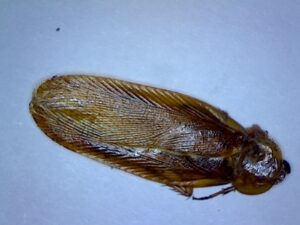
The western wood cockroach (Paroblatta Americana) is a North American species of wood roaches that live outdoors, specifically in grasslands. However, it has been indoors once in a home in Washington state.
The difference between both sexes is very apparent in western wood cockroaches since males typically have a shiny brown color with wings, whereas females have no wings and are darker in color.
Both genders also have different habits. For example, females and their nymphs often live under the ground and in rotting wood, whereas males are (surprisingly) attracted to light and fly out to nibble at plants.
Sand Cockroaches
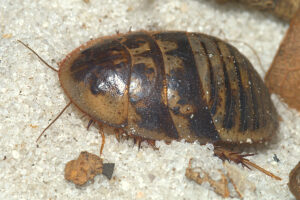
Sand roaches are those in the family Corydiidae and have spread out across 40 genera. The most popular is the desert cockroach (Arenivaga investigata), found abundantly in sand dunes in the Colorado desert, USA.
Sand roaches are easy to distinguish since they’re typically very pale, and some are almost white.
Because they evolved in desert conditions, many sand roaches can absorb water from the vapor in the atmosphere.
Roaches And Humans
“Roaches and humans” isn’t a phrase that arouses many people’s minds. But, unfortunately, the phrase probably does the opposite of that.
That’s because when we think of roaches, we often think of cockroach infestations or cockroach allergens, which are common household problems caused by this sturdy insect that we’ll talk about here.
However, cockroaches are more than disgusting or scary pests for many humans. Now we know this sounds gross, but we think it offers an essential perspective on how different cultures view this bug.
Besides, we’re talking about the relationship between roaches and humans here, and it wouldn’t be fair to include only our hatred and selectively exclude how other cultures live with roaches.
So without further ado, let’s get into it.
Cockroach Infestation Problems
From a western perspective, roaches are disgusting and dirty pests that hide in our houses and spook us when we’re least expecting it. And sure, this has a lot of merit to it. But, unfortunately, cockroach infestations are a huge problem for homeowners in the west.
Many people hire extermination services at least once a year to ensure their living spaces have not littered with roaches or other insects, for that matter.
Indeed, roaches aren’t exactly the most hygienic creatures as well. Cockroach bites can be devastating since they can deliver a lethal dose of deadly bacteria that they’ve collected from who-knows-where. Hell, even touching a roach can transmit this bacteria.
Cockroaches As Food
OK, we can imagine how disgusted you are right now just from reading this headline. But you probably already knew that some cultures in East Asia and Latin America eat roaches.
It’s not the same as eating stray roaches, though. Cockroach farming is a venturous business in these countries, and the roaches are bred under lab conditions to ensure they’re not carrying any bacteria or viruses.
Think of it like shrimp – the head and tails removed, then the body is boiled, grilled, sauteed, or whatever, and then served. And in all fairness, roaches (and other insects) are packed with protein.
Cockroaches As Traditional Medicine
Some traditional medical recipes have “cockroach” on their ingredients list, mainly in China. For example, a recipe in China includes frying the roaches, grinding them up, and selling them as pills for stomach, heart, and liver problems.
The Bottom Line
It’s been a wild ride. We hope you now know a little more about the rich history of the extremely hardy cockroach. We don’t expect you to change your mind about roaches, but we appreciate their impressive evolutionary history and adaptability! Also, learn to live with them on Earth because these hardy beasts are going nowhere.
Related Content:
Bugs that Look Like Bed bugs: 12 Insects Mistaken for Bed bugs
What Attracts Bed Bugs?
15 DIY Bed Bug Heaters
References
- https://www.pestworld.org/news-hub/pest-articles/fascinating-cockroach-facts/
- https://www.newworldencyclopedia.org/entry/Cockroach
- https://www.ncbi.nlm.nih.gov/pmc/articles/PMC4511787/
- https://entomologytoday.org/2017/10/10/old-but-not-that-old-debunking-the-myth-of-ancient-cockroaches/
- https://www.livescience.com/oldest-cave-dwelling-animal-cockroaches.html
- https://animals.howstuffworks.com/insects/cockroach1.htm
- http://cockroach.speciesfile.org/HomePage/Cockroach/Diversity/Diversity.aspx
- http://www.bio.umass.edu/biology/kunkel/cockroach_faq.html
- http://fossilworks.org/?a=taxonInfo&taxon_no=284634&is_real_user=1
- https://journals.plos.org/plosone/article?id=10.1371/journal.pone.0080560
- https://www.bbc.com/news/science-environment-22611143
- http://edition.cnn.com/travel/article/china-cockroach-farming-food/index.html

